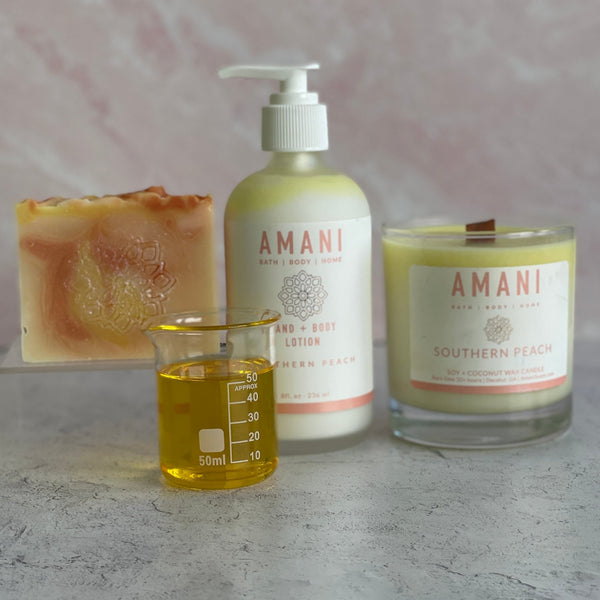Technical Tuesday: Why do some products discolor?
Oct 14, 2022
You may have noticed that some candles and lotion (particularly Southern Peach and Zanzibar Spice) can be white, cream, yellow. What's up with that?
The culprit is the fragrance. I use both essential and fragrance oils in my products. Essential oils are plant-derived oils that, by definition, are made by water or steam distillation or mechanical pressing. In other words, they must be made by physical means, without the use of solvents. Fragrance oils are synthetic products that are generally proprietary, meaning the manufacturer is not required to disclose the full ingredients. Think of soda; you can be sure that Coke is not going to share their secret formula with anyone, but most folks drink it without a second thought. Contrary to what you might think, many fragrance oils do, in fact, use essential oils as a component of the complete fragrance.
Side note: Manufacturers are required to publish the maximum usage rates for all potential product categories including soap, lotion, candles, lip balm, air freshener, baby wipes, etc. The use rate depends on where and how the product will be used. For example, wash off product like soap will have a higher usage rate than an eye cream. Companies who make scented products, such as myself, are also required to ensure that all the fragrances they use are below those limits.
Some fragrance and essential oils are very dark in color. Orange essential oil is dark orange, so products containing it will eventually turn yellow or orange. (Unless you use de-colorized essential oil, which is an actual thing.) As I mentioned above, one fragrance I use is Southern Peach. I don't know the actual composition of the Southern Peach fragrance, however I am pretty certain it contains orange essential oil since they're both fruity scents.
First and foremost, I want to emphasize: products which discolor are perfectly safe to use. Discoloration is not a sign of a "bad" product; it's strictly a function of chemistry. Makers know which products will discolor and will often choose to work this into their product design. Sticking with the Southern Peach example, my soap is orange, yellow, and white. Since I know it will discolor, I only put the fragrance oil in the parts which I intend to color orange and yellow; I leave it out of the white portion.
The same is true for products with vanilla. Vanillin is the primary component of natural vanilla but synthetic versions are most common in fragrances due to cost.* There is an additive called vanilla color stabilizer that can slow down the process, but the soap will still turn brown eventually. Since it will happen even with the stabilizer, I don't use it. I like to keep my products as simple as possible.
My Oatmeal Goat's Milk soap uses a blend of two fragrances: Milk & Honey and Very Vanilla. Below you can see two examples of these soaps; I have not edited the photo in any way beyond cropping it. For this design, I use a brown mica and black activated charcoal along with a portion of the soap batter that has no color added. These two soaps are identical except for one thing: the top bar has both fragrances in the entire batch while the bottom bar does not have Very Vanilla in the portion with no added color (in other words, the brown and black portions have both Milk & Honey and Very Vanilla while the uncolored part only has Milk & Honey.) The difference in color is entirely due to the presence of the Very Vanilla fragrance.

When it comes to candles and lotion, some fragrances will also cause them to turn yellow. Exposure to UV light can speed up this process. Interestingly, the Milk & Honey fragrance does not discolor lotion or candles and I have no idea why!
Some candle makers dye their wax (for example, as a means to distinguish products with different fragrances or to mitigate discoloring fragrances.) You can also color lotion, although this is less common. I personally prefer un-dyed candles and lotion so I do not use color with these and have just accepted that these products are going to change color. I am planning to experiment with a different supplier for my fragrance in hopes that it won't discolor as much. Stay tuned for those results...
Here you can see a bit of discoloration in Zanzibar Spice lotion. This photo was taken professionally so it has been edited slightly but I asked the photographer not to change the color of the product so that customers know what to expect.

And here you can see my non-professional, non-edited photo of Southern Peach fragrance and products. You can easily see that the top portion of the lotion and candle have a slight yellow color.

So what's the take home message?
- Many fragrances can discolor soap, lotion, or candles
- Primary culprits tend to be dark colored fragrances or products containing vanilla
- Exposure to UV light can speed this process
- Discolored products are not indicative of a problem
If you have questions regarding product discoloration, please submit a comment or drop me an email at hello@amanisoaps.com
*A bit more about vanilla...Despite what you might read, there's no such thing as "vanilla essential oil". The closest option is vanilla oleoresin, a thick sticky paste that is incredibly expensive. A careful read of a product description will generally show how the business has gotten around this. Manufacturers might call something "vanilla essential oil" but it is actually a small amount of vanilla oleoresin cut with a carrier oil like coconut oil (and even then it is still extremely pricy.)

